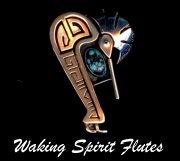Vol. 33, No. 19
onCampus Home
OSU LINKS
News & Information
Research News
Trustees
Faculty/Staff Page
OSU Home |
5-10-2004
By: Susan Wittstock
Flute class instills Native American spirit
Somewhere down the hall in the basement of Hughes Hall, a class has let out. The students, shouldering backpacks and sauntering toward the stairwell, keep glancing into room 08 with raised eyebrows. Used to hearing the sounds of instruments drifting from open classroom doors, their faces show surprise when the drone of a power sander reverberates into the hallway.
Peeking inside, they might see a dozen or so students informally scattered throughout the classroom. Some are seated, carving animals out of small blocks of wood. Others are sanding long stretches of wood to a smooth finish. A few are cutting thin strips from leather.
The view from the hall offers a snapshot of a spring quarter’s worth of effort: the construction of Native American Flutes.
Professor Jim Akins is teaching this class for the first time this year. The three-credit course meets on Monday and Tuesday afternoons and offers an introduction to the history and use of Native American Flutes. Rather than just teaching about the instrument, Akins is guiding each student through the process of making a flute.
The course had its genesis in Akins’ hobby of archery. “Old style archery,” Akins said. “Robin Hood style, with a bow and arrow. I thought it would be fun to make a set.”
He did, and when his interest turned to Native American Flutes a few years ago, the idea of making one of those didn’t seem so difficult. He bought a flute and by examining it carefully, figured out how to make it. He estimates that in the past year, he’s made about 80 more.
Akins, the principle tuba for the Columbus Symphony Orchestra for the past 23 years, normally teaches tuba and euphonium in the School of Music. As he conducted research on the flutes, tracking down books that showed traditional tribal motifs that he could incorporate into his flutes, he began to realize he had great material for a class.
“I found out that, nationally, there is no full-credit course like this. A few schools offer Native American music courses, but no one actually builds the flutes,” Akins said.
He received support from the Multicultural Center and the go-ahead from the School of Music to develop the class. Course work includes exposure to books about Native American Flutes and CDs of the music, an overview of prominent performers, and tutorials on how to play the flute.
And then there’s the actual physical work of the class, the kind that generates sawdust and leads to hands wielding planers and knives and sandpaper.
Akins provided students with the choice of two kinds of kits they could use to build their flutes from. He obtained western cedar kits from a Cherokee flute maker, Waking Spirit, and darker wood kits of eastern cedar from Ojibway flute maker Raymond Redfeather.
“I wanted to make sure that Native American spirit is a part of the students’ finished product,” Akins said. “I use kits from these two fine men as they make extremely fine flutes themselves. I own a few from both and count them as treasures. I use their kits to honor them and the spirit they instill in their work.”
Having kits available meant Akins didn’t have to supervise students using lathes to bore out the inside of the flutes. Students glued together the wood pieces provided in the kits; carved them into the shape of a flute, with lengths averaging about 20 inches; and drilled the holes needed for playing. Typically, the flutes are decorated with designs of the maker’s choosing. A number of the 21 students enrolled in the class are either full-blooded Native Americans or have Native American ancestry, so many have selected designs that reflect their heritage. Akins himself has some Powhatan ancestry.
The students have progressed at their own pace, consulting with Akins and each other as they tackle each new step in the process. Akins has supplied his own batch of tools, arrayed across his desk, and he regularly arrives early and leaves late to accommodate students putting in extra time. A table in the front of the classroom is laden with more than a dozen of the flutes he has finished. The flutes are smooth and silky to the touch and are lightweight when lifted. Some have intricate designs and symbols burned onto the surface, others depict small scenes showing hunters or animals. They all have ‘birds’ — carved figurines that attach to the top of the flute that help create the flute’s sound when air is blown through the instrument.
“It’s fun when they make their first sound, fun to see everybody’s face light up,” Akins said.
At a recent session, Akins’ desk was consistently shadowed by three or four students, leaning in to hear and see as he worked through individual questions. One student, waiting for his turn, stepped back slightly. He lightly held his nearly finished flute, a honey-colored instrument, and raised it up and blew through the mouthpiece. The notes, reedy and clear, cut through the room.
Music class, after all. |
|

